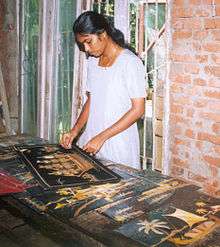Straw painting

Straw paintings are craft objects made by shaping straw into patterns and representational images.
By modeling and playing with straw, people, especially women, started weaving straw into artistic objects. As time passed, they acquired more skill in working with straw and a century ago, created a very specific art, the art of weaving straw into pictures by using and combining the natural colours and shades of oats, barley, rye, wheat, and other grasses. These "paintings" have become a speciality of China, Mexico, and Subotica in Serbia and its vicinity.
China
Straw patchwork art is a Chinese folk art that dates back to the Han Dynasty (250—230 CE) and developed during Sui Dynasty of 581—618 CE. During the Song Dynasty (960—1127 CE), straw patchwork was enjoyed by royalty. Wheat straw is smoked, steams, whitening, dyed, cut, and altered in a myriad of procedures to fashion delicate representational works.[1] Today wheat straw patchwork is a decorative art and popular item for tourists to China.
Mexico and southern California

In Mexico, straw mosaics are known as "popotillo art," from the Spanish name for sacaton grass, Sporobolus, or popote de cambray. The art form has Precolumbian roots.[2]
The grass grows in states of Mexico, Morelos, Hidalgo, and Puebla. Mexico City is the center of popotillo art, and several award-winning artists have formed a workshop, "Popotillo y Color," there.[2] While common in the 19th century, popotillo art enjoyed the most popularity in the 1930s and 1940s in Mexico City. Popotillo workshops have been offered in Los Angeles, California.[3]
The grass is first hand-dyed. Before European contact, exclusively natural dyes were used and the straw was soaked in aguamiel or agave juice.[3] Then the artist draws a design, which is then covered by a fine layer of "cera de Campeche," a special type of beeswax. The straw is then cut down to workable sizes, sometimes as fine as a single millimeter in length. The artist then carefully presses the pieces of straw into the beeswax. When the design is finished, a fixative is applied to protect the finished work.[2]
References
- ↑ "Runchuan Arts and Crafts Co., Ltd." CCTV Directory. (retrieved 9 Jan 2010)
- 1 2 3 "Papel Picado, Papel Amate, and Popotillo." Festival of Mexico. (retrieved 9 Jan 2010)
- 1 2 "Popotillo art." Popular Arts Foundation. (retrieved 9 Jan 2011)
External links
- Popotillo Galeria, Artesania Mexicana
- Marcela Brčić Kostić & Ljiljana Letić
- HKPD Matija Gubec Tavankut
- From Grain to Painting (film web site)